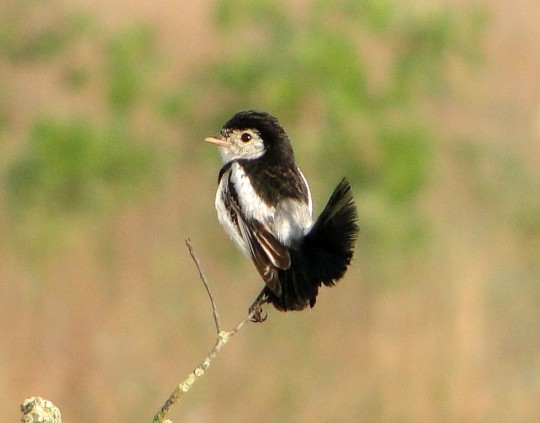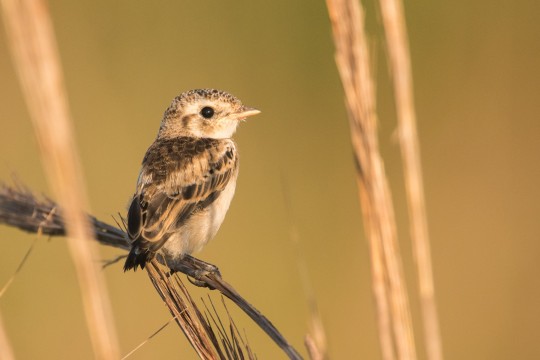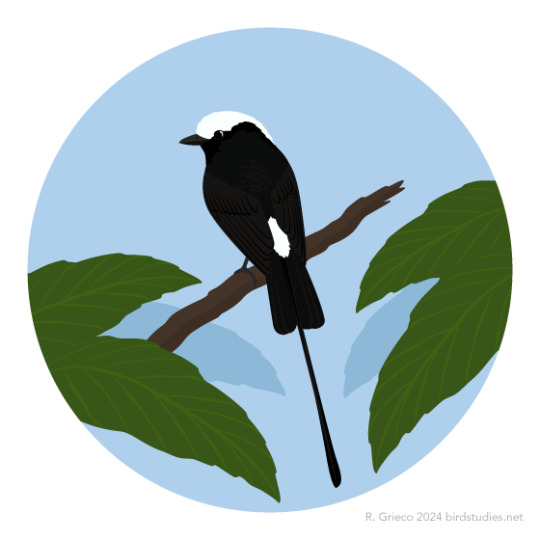#in the tyrant-flycatcher family
Explore tagged Tumblr posts
Text






Just some random bird shots I took a few weeks back
Story: I decided to take a small drive to a bird preserve just outside the town I live in. The trail i was on went in a loop back to the parking lot, and just as I was heading back to my car, I saw this bird consistently flying back and forth to this sign. I decided to spend some time there and practice my shutter speed in order to catch the bird flying in motion. How did I do?
#photography#lightroom edits#bird in flight#consumes river preserve#bird sanctuary#photographers on tumblr#bird type:black phoebe#passerine bird#in the tyrant-flycatcher family
2 notes
·
View notes
Text

The pied-crested tit-tyrant (Anairetes reguloides) is a species of bird in subfamily Elaeniinae of family Tyrannidae, the tyrant flycatchers. It is found in Chile and Peru
271 notes
·
View notes
Text



the painted tody-flycatcher is a small member of the tyrant flycatcher family. endemic to south america, they are found in the guianas and a small portion of northeastern brazil. these birds haven’t been studied extensively, and some of their behaviors are a mystery. however, as their name implies, we know they are talented at catching insects, which make up most of their diet. additionally, the species does not seem to be sexually dimorphic, with both sexes displaying primarily bright yellow plumage.
1K notes
·
View notes
Text


[2524/11080] Cock-tailed tyrant - Alectrurus tricolor
(top photo: adult male, bottom photo: juvenile)
Order: Passeriformes Suborder: Tyranni Family: Tyrannidae (tyrant flycatchers)
Photo credit: Carlos Otávio Gussoni/Claudia Brasileiro
429 notes
·
View notes
Text

March 4, 2024 - Long-tailed Tyrant (Colonia colonus) Found in parts of Argentina, Bolivia, Brazil, Colombia, Costa Rica, Ecuador, French Guiana, Guyana, Honduras, Nicaragua, Panama, Paraguay, Peru, Suriname, and Venezuela, these tyrant flycatchers live in forests and woodlands, often around water. Hunting in short flights from exposed perches in pairs or family groups, they feed on insects, including stingless bees and beetles. They build their nests from leaf stems in cavities in tree trunks or snags. Females lay clutches of two or three eggs.
84 notes
·
View notes
Text
Round 3, Poll 13
Wedge-tailed Eagle vs Short-tailed Pygmy-tyrant


sources under cut
Wedge-tailed Eagle
“they’re friggin’ huge, they can have a wingspan of over 9 feet, I’m always just completely in awe when I see them. also, great legs.”
As a true generalist, anything is on the menu for this eagle. They seem to prefer mammals, especially the invasive European rabbit, but will also hunt native marsupials, including larger macropods (kangaroo). Because of this wide diet they’ve got a range that encompasses all of Australia and Tasmania.
Wedge-tailed Eagle have been noted to attack hang gliders and paragliders, though they are mostly targeting the sail itself and not the human. They’ve also been known to attack unmanned aerial vehicles used for survey operations. This is likely territorial defense, with the eagles mistaking these objects as another eagle.
Short-tailed Pygmy-tyrant
“small. hilarious name-bird combo”
“the smallest bird in the world after several species of hummingbirds. Naming this beast a "tyrant” is the funniest thing ever. Also I’m tail-shaming it" (for reference: tyrant refers to the family this bird belongs to- tyrant flycatchers, which are named after kingbirds)
“Although its plumage is similar to some other tyrant flycatchers, in the field the bird is more often mistaken for a large beetle or insect, especially while in flight… Its flight movements have a mechanical-feel that enhances the insect comparison.” - Wiki
Images: Eagle (Luke Shelley); Flycatcher (Anselmo d'Affonseca)
#hipster bird main bracket#round 3#quarterfinals#bird poll#animal poll#Wedge-tailed Eagle#Short-tailed Pygmy-tyrant
44 notes
·
View notes
Text
So, just like my previous post on the First Stoat's names let's look into the new information we found out in the latest episode (Burrow's End episode 8 spoilers under the cut)
So let's get the most important thing out of the way first, cause there's a lot to go through here: Obviously, Phoebe also means light - the name originates from the Ancient Greek word φοῖβος (phoibos) for "pure", "bright", "radiant" etc.
The word itself was used as an epithet for the sibling deities Apollo (god of, among other things, sun and prophecy) and Artemis (goddess of, among other things, the moon, wild animals, and the hunt). They inherit this name from their grandmother, the Titaness Phoebe who is associated by proxy with the moon and prophecy, but not actually a deity of anything. For her, it seems to be mostly a name, while it is used more akin to a title for her grandchildren.
In honour of Phoebe the Titan, one of the moons of Saturn has been named after her. It is called an irregular satellite, meaning it follows an eccentric, distant orbit which also happens to be retrograde (aka it moves opposite to the rotation of the body it orbits). With a diameter of 213km Phoebe is the most massive of Saturn's irregular satellites, and the second largest retrograde satellite in the Solar System (after Neptune's moon Triton).
There is a Phoebe mentioned in the Bible (New Testament, Paul's Epistle to the Romans). She is described as a deacon (apparently the only woman named as a deacon in the Bible) and Paul speaks highly of her - from skimming the Wikipedia article on the biblical Phoebe this part seems to be some kind of letter of recommendation. It is unclear, what community Paul intends to recommend her to, but some scholars seem to believe that she was, in fact, the emissary who delivered Paul's epistle to Rome in the first place.
(Incidentally, the aforementioned Wikipedia article mentions that the Catholic Church puts her feast day on September 3rd which is my birthday, and my chosen name is Paul, which has nothing to do with this meta, but I just found it funny.)
Anyways. There is also a species of bird called Phoebe in the tyrant flycatcher family (aka Tyrannidae); they live on insects and originally got their scientific name from being loudly territorial and aggressive. And since we, apparently, don't have enough things called Phoebe yet, there's also a genus of evergreen laurels called Phoebe.
To me, this paints a vivid picture: A Titan specifically known for being the progenitor of the Sun and Moon deities, somebody associated with prophecy ("She'll come back" comes to mind as a pertinent prophecy we have on her right now). Phoebe is, of course, the only female First Stoat we have encountered so far. I have a few unformed thoughts on the whole 'emissary' bit (which is, arguably, the piece of information with the least solid grounds presented here; but still, why is Phoebe gone from Last Bast in the first place? Is she an emissary sent by the First Stoats to somewhere else/the humans? How did the First Stoats conquer Warren Peace originally - they didn't just do that on their own, maybe they are the 'emissaries' sent there to actively sabotage the plant?).
The one thing I am certain of, is that First Stoat Phoebe is going to be just as territorial and aggressive as her Tyrannidae namesakes, if not more so.
#burrow's end#d20#first stoats#d20 spoilers#burrow's end spoilers#f: d20#f: burrow's end#c: phoebe (be)#oh also the evergreen bit obviously is a connection to her being similarly 'immortal' as the other first stoats#i am also having thoughts on reactor charlie being her heart and that being connected to how she isnt at last bast currently#and also the themes of the bear's heart & tula's heart & ava's heart & now phoebe's heart#but i'll have to rewatch eps 6 & 7 for those to crystallize into coherence
27 notes
·
View notes
Text


The Eastern Kingbird (tyrannus tyrannus) is part of the family of "tyrant" flycatchers. I learned this morning that their name comes from the fact that they'll aggressively drive off other, larger birds that get near their nests, but it's still funny to me as a name for a fluffy songbird
24 notes
·
View notes
Text

Eastern Phoebe
This fellow and his mate have been hanging around my grandparents’ cabin. He isn’t very colorful, but he more than makes up for it with his boldness.
Most members of the tyrant-flycatcher family are shy around humans, but phoebes are a notable exception. I often see them on rooftops and in peoples’ yards, acting as though they own the place.
12 notes
·
View notes
Text

The pied-crested tit-tyrant is a species of bird in subfamily Elaeniinae of family Tyrannidae, the tyrant flycatchers. It is found in Chile and Peru.
1 note
·
View note
Note
For Phoebe: If there any bird you really want to see, what would it be?
That's a good question! My favorite bird is the eastern phoebe, but I see them all the time in my backyard, so I don't think that counts as an answer.
Hmmmm..... I would love to see some of the eastern phoebe's tropical cousins. They're all tyrant-flycatchers-- insect-eating songbirds native to the Americas. There are over 400 species in that family, and I've only seen a handful of them!
1 note
·
View note
Text

The dusky capped flycatcher from the *tyrant flycatcher* family, obviously very much a round dinosaur

The Shoebill an obvious dinosaur with stork like abilities
What a time to be alive, walking among dinosaurs.

the duality of pterosaurs
(based on the BIG PANT or BIG JAKT meme going on twitter)
1K notes
·
View notes
Text

The great crested flycatcher (Myiarchus
crinitus) is a large insect-eating bird of the tyrant flycatcher family.
98 notes
·
View notes
Text
Tyrant flycatchers are insanely diverse (it's the largest family of birds, currently I think estimated at around 447 species) despite only being present in north and south America, with most of their diversity in south and central America. But while south America is probably the most diverse bird place in the world, its also not short of competition, many other bird lineages either originated from south America itself or have been present there since well before the origin of the family, and unlike hummingbirds the niches they occupy are not particularly unique, their extreme diversity seems to be an example of competitive success rather than finding a wholly unique niche. If for example, some population of tyrant flycatchers managed to make it across the Atlantic to tropical Africa, or by rafting or island hopping to the indopacific, would they have explosive success too? Or is their success limited to some features endemic to the Americas?
0 notes
Text

[2975/11080] d'Orbigny's chat-tyrant - Ochthoeca oenanthoides
Order: Passeriformes Suborder: Tyranni Family: Tyrannidae (tyrant flycatchers)
Photo credit: Carlos Cabrera via Macaulay Library
#birds#d'Orbigny's chat-tyrant#Passeriformes#Tyranni#Tyrannidae#Ochthoeca#birds a to z#undescribed#25% - 50%
81 notes
·
View notes
Text

August 3, 2023 - Social Flycatcher (Myiozetetes similis) Found from Mexico to central South America, these tyrant flycatchers live in semi-open habitats with some bushes and trees, often near water. They feed on insects and fruit, as well as tadpoles, foraging in pairs or family groups after the breeding season and gathering in large flocks at fruiting trees. Females build bulky domed nests with side entrances from dry grass, straw, weed stems, small twigs, and often cotton, paper, and strands of plastic in trees, bushes and other locations, including human-created structures. They often nest near bee, wasp, or stinging ant nests, frequently in the same tree or bush as other species of tyrant flycatchers. Females incubate clutches of two to four eggs alone.
#social flycatcher#tyrant flycatcher#myiozetetes similis#bird#birds#illustration#art#water#birblr art
66 notes
·
View notes